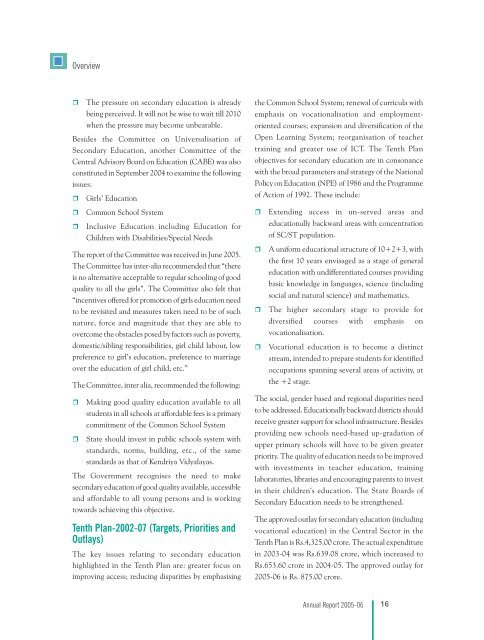all files - Azim Premji Foundation
all files - Azim Premji Foundation
all files - Azim Premji Foundation
You also want an ePaper? Increase the reach of your titles
YUMPU automatically turns print PDFs into web optimized ePapers that Google loves.
Overview<br />
r The pressure on secondary education is already<br />
being perceived. It will not be wise to wait till 2010<br />
when the pressure may become unbearable.<br />
Besides the Committee on Universalisation of<br />
Secondary Education, another Committee of the<br />
Central Advisory Board on Education (CABE) was also<br />
constituted in September 2004 to examine the following<br />
issues:<br />
r Girls’ Education<br />
the Common School System; renewal of curricula with<br />
emphasis on vocationalisation and employmentoriented<br />
courses; expansion and diversification of the<br />
Open Learning System; reorganisation of teacher<br />
training and greater use of ICT. The Tenth Plan<br />
objectives for secondary education are in consonance<br />
with the broad parameters and strategy of the National<br />
Policy on Education (NPE) of 1986 and the Programme<br />
of Action of 1992. These include:<br />
r Common School System<br />
r Inclusive Education including Education for<br />
Children with Disabilities/Special Needs<br />
The report of the Committee was received in June 2005.<br />
The Committee has inter-alia recommended that “there<br />
is no alternative acceptable to regular schooling of good<br />
quality to <strong>all</strong> the girls”. The Committee also felt that<br />
“incentives offered for promotion of girls education need<br />
to be revisited and measures taken need to be of such<br />
nature, force and magnitude that they are able to<br />
overcome the obstacles posed by factors such as poverty,<br />
domestic/sibling responsibilities, girl child labour, low<br />
preference to girl’s education, preference to marriage<br />
over the education of girl child, etc.”<br />
The Committee, inter alia, recommended the following:<br />
r<br />
r<br />
r<br />
r<br />
Extending access in un-served areas and<br />
education<strong>all</strong>y backward areas with concentration<br />
of SC/ST population.<br />
A uniform educational structure of 10+2+3, with<br />
the first 10 years envisaged as a stage of general<br />
education with undifferentiated courses providing<br />
basic knowledge in languages, science (including<br />
social and natural science) and mathematics.<br />
The higher secondary stage to provide for<br />
diversified courses with emphasis on<br />
vocationalisation.<br />
Vocational education is to become a distinct<br />
stream, intended to prepare students for identified<br />
occupations spanning several areas of activity, at<br />
the +2 stage.<br />
r<br />
r<br />
Making good quality education available to <strong>all</strong><br />
students in <strong>all</strong> schools at affordable fees is a primary<br />
commitment of the Common School System<br />
State should invest in public schools system with<br />
standards, norms, building, etc., of the same<br />
standards as that of Kendriya Vidyalayas.<br />
The Government recognises the need to make<br />
secondary education of good quality available, accessible<br />
and affordable to <strong>all</strong> young persons and is working<br />
towards achieving this objective.<br />
Tenth Plan-2002-07 (Targets, Priorities and<br />
Outlays)<br />
The key issues relating to secondary education<br />
highlighted in the Tenth Plan are: greater focus on<br />
improving access; reducing disparities by emphasising<br />
The social, gender based and regional disparities need<br />
to be addressed. Education<strong>all</strong>y backward districts should<br />
receive greater support for school infrastructure. Besides<br />
providing new schools need-based up-gradation of<br />
upper primary schools will have to be given greater<br />
priority. The quality of education needs to be improved<br />
with investments in teacher education, training<br />
laboratories, libraries and encouraging parents to invest<br />
in their children’s education. The State Boards of<br />
Secondary Education needs to be strengthened.<br />
The approved outlay for secondary education (including<br />
vocational education) in the Central Sector in the<br />
Tenth Plan is Rs.4,325.00 crore. The actual expenditure<br />
in 2003-04 was Rs.639.08 crore, which increased to<br />
Rs.653.60 crore in 2004-05. The approved outlay for<br />
2005-06 is Rs. 875.00 crore.<br />
Annual Report 2005-06<br />
16

















